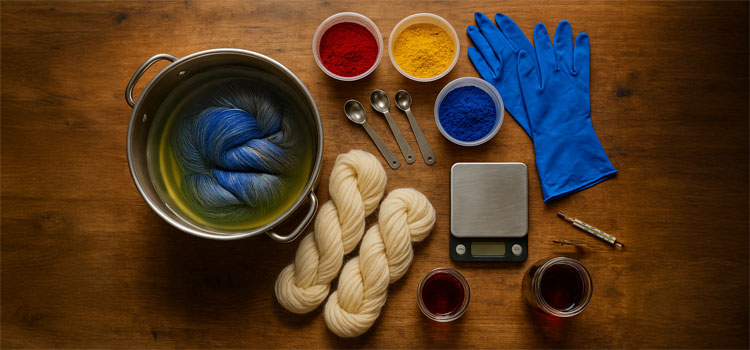Tutorials & Tips, Yarn Dyes
Fiber dyeing at home: A complete beginner’s guide without the stress
Introduction – Fiber Dyeing: Bring Your Textile Creations to Life
Fiber dyeing is more than just a technique… it’s a deeply personal way to explore color, play with textures, and create fiber that truly reflects your creative voice. Sometimes, all it takes is a handful of raw wool and a few well-chosen pigments — and suddenly, you’ve created colors that are unique, vibrant, and found nowhere else.
When you dye your own fibers, you’re not just adding color to materials — you’re putting a part of yourself into the process. Whether your passion is knitting, weaving, spinning, or felting, fiber dyeing opens the door to endless exploration where every project becomes its own creative lab.
By selecting the right products — like Jacquard, Greener Shades, or Ashford — and mastering a few essential steps, you can create vibrant, durable fibers that perfectly suit your handmade projects.
This guide will walk you through how to successfully start fiber dyeing at home, whether you’re working with wool, silk, bamboo, or other natural fibers. You’ll discover the best techniques to use, mistakes to avoid, the most suitable dyes for each fiber type, and the basic tools to get started.
🎨 Ready to dive into the colorful world of fiber? Let’s begin!
Table of Contents
Why Dye Your Own Natural Fibers at Home?
A Creative and Sustainable Practice
Dyeing your own fibers means reclaiming full creative control over the colors in your textile projects. Whether you’re going for a soft, earthy palette or bold, modern tones, fiber dyeing lets you personalize every strand and skein to match your artistic vision.
It’s also a more eco-conscious approach. You can choose heavy-metal-free dyes (like Greener Shades), opt for local or organic fibers, and be intentional with your use of water and resources.
Give Your Projects Extra Value
Hand-dyed fibers offer incredible depth and richness to your work — whether it’s yarn, woven cloth, or finished garments. Each gradient, tonal shift, or speckled effect adds artisan value and character that transforms an ordinary skein into something truly special.
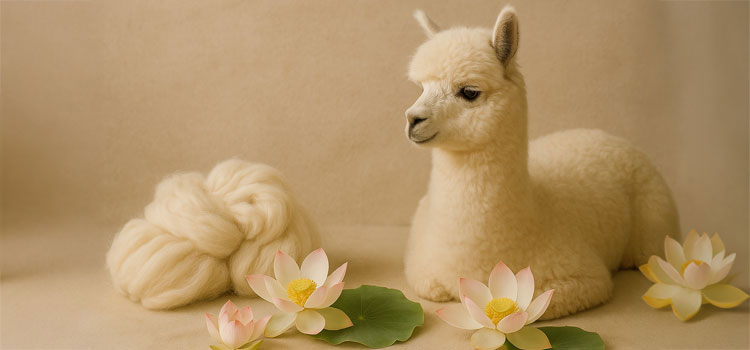
What Fibers Can Be Dyed at Home?
Animal-Based Fibers: Wool, Alpaca, Silk, Mohair…
Protein fibers — those that come from animals — are ideal for home dyeing. This includes:
These fibers absorb color beautifully, especially when using acid dyes such as those from Jacquard, Ashford, or Greener Shades.
➡️ Pro Tip: Superwash wool helps dye pigments spread more evenly and reduces the risk of felting.
Plant-Based Fibers: Linen, Bamboo, Cotton, Lotus
Cellulose-based fibers (from plants) require fiber-reactive dyes like Procion MX. These dyes bond with the fiber at room temperature using soda ash and non-iodized salt.
Some excellent examples of dyeable plant fibers available at Artigina:
These fibers are perfect for macramé, weaving (tapestry or loom), and other textile art projects.
➡️ Warning: Acid dyes do not adhere well to plant fibers. Always choose the right dye for the type of fiber you’re working with.
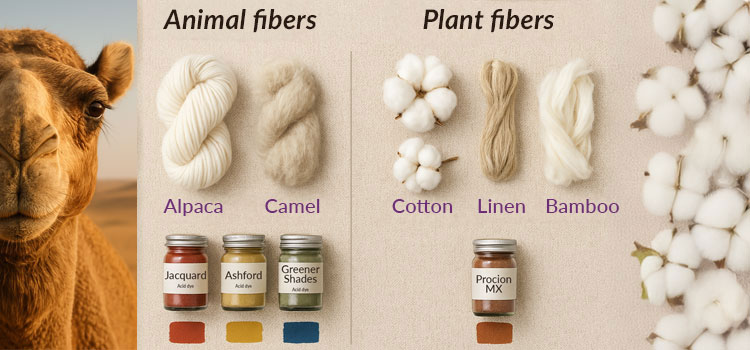
How to Choose the Right Dye for Your Fiber Type
Choosing the right dye is essential to ensure your fiber takes on color beautifully — and that the result holds up to washing and wear. Here’s how to make the best choice depending on the type of fiber you’re working with.
Acid Dyes: Bright, Long-Lasting Color for Animal Fibers
Acid dyes (like those from Jacquard, Ashford, or Greener Shades) are formulated to fix color onto protein-based fibers like wool, alpaca, silk, and mohair.
They’re known for delivering vibrant, luminous, and long-lasting colors, and they’re fairly simple to use at home: all you need is a heated bath, some vinegar or citric acid, and gentle stirring.
✅ Recommended Acid Dyes:
-
Jacquard Acid Dyes – Wide color range, strong colorfastness
-
Ashford Dyes – Easy to measure and use, ideal for beginners
-
Greener Shades – Metal-free formulation, perfect for eco-conscious projects
Procion MX Dyes: Best for Plant-Based Fibers
If you’re dyeing cotton, linen, or bamboo, Procion MX cold-reactive dyes are the best choice. They bond at room temperature, making them great for delicate fabrics, and are activated using soda ash and salt.
These dyes are also ideal for certain mixed or textured plant fibers, like modal and Tencel.
➡️ You can also use Procion MX to create special effects such as tie-dye, snow dye, or batik.
Choose Based on Your Project
| Main Fiber | Recommended Dye | Fixation Method |
|---|---|---|
| Wool, Silk, Alpaca | Jacquard, Ashford, Greener Shades | Heat + vinegar or citric acid |
| Cotton, Linen, Bamboo | Procion MX | Salt + soda ash at room temperature |
| Fiber blends (e.g. wool/bamboo) | Testing recommended | Match dye to the dominant fiber type |
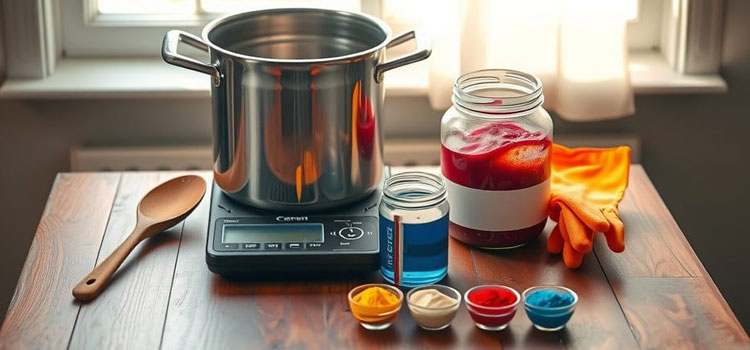
Essential Tools to Start Dyeing Fiber
Whether you’re working with acid dyes or fiber-reactive dyes, a few key tools will ensure your dyeing process is safe, even, and successful. Here’s the ideal beginner’s kit for any fiber enthusiast looking to start dyeing at home:
🔹 Heat-Resistant Equipment
-
Stainless steel or enamel dye pot
Use this pot only for dyeing (not for food). It should be large enough to allow fiber to move freely in the dye bath. -
Wooden spoon, stainless steel stick, or stirring rod
For gently moving your fibers in the bath. -
Cooking thermometer or dye thermometer
Crucial for acid dyeing — temperature affects how well the dye bonds to the fiber. -
Precision scale
Helps you accurately measure dye powder based on the weight of your fiber (e.g. 1% weight of fiber = medium intensity color).
Protective Gear
-
Rubber gloves
Always wear gloves when handling dye powders and wet fiber. -
Respirator mask (optional)
Especially recommended when working with powdered dyes. -
Apron or dark old clothing
Protect yourself from splashes or stains.
Fixatives Depending on the Dye Type
| Dye Type | Fixative | Purpose |
|---|---|---|
| Acid (Jacquard, Ashford, Greener Shades) | White vinegar or citric acid | Lowers pH to ~4.5 for color bonding |
| Reactive (Procion MX) | Soda ash + non-iodized salt | Enables bonding on cellulose fibers |
Other Useful Products
-
Neutral textile soap or Synthrapol®
For pre-washing your fiber and for post-dye rinsing to remove excess pigment. -
pH meter or pH test strips (optional)
Helpful for precise dyeing or large batches. -
Protective sheets or placemats
To cover your work area and keep it clean.
Tips Before You Start
➡️ Dedicate a separate set of tools for dyeing — especially when using acid or reactive dyes. Don’t reuse these for cooking.
➡️ New to dyeing? Try a starter kit that includes fiber, dye, and a how-to guide.
➡️ Adjust dye quantity to fiber weight. As a general rule:
-
0.5% WOF = light tone
-
1% WOF = medium tone
-
2% WOF = deep or saturated tone
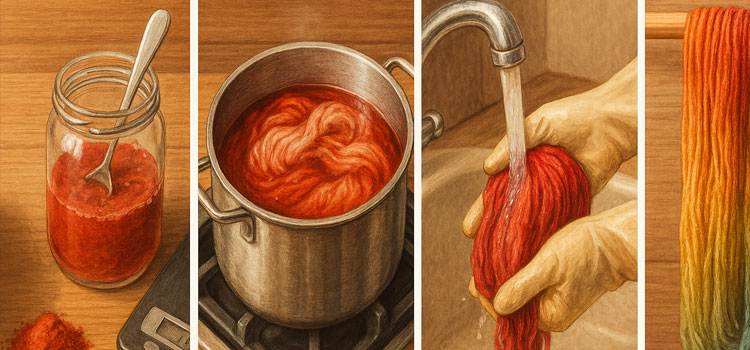
Step-by-Step Process for Successful Fiber Dyeing
Dyeing natural fibers requires patience, precision… and a bit of magic! Whether you’re working with wool, silk, or cotton, follow these essential steps to achieve vibrant, even, and lasting color results.
1. Prepare the Fiber
Before applying dye, your fiber should be clean, grease-free, and thoroughly saturated with water.
-
Gently wash it using a neutral textile soap (like Synthrapol®) to remove oils, treatments, or dust.
-
Rinse well and soak in lukewarm water for 15 to 30 minutes.
-
⚠️ For delicate fibers (like alpaca, angora, or silk), avoid agitation or sudden temperature changes to prevent felting.
➡️ Soaking ensures even absorption of the dye.
2. Prepare the Dye Bath
🔸 For Acid Dyes (Jacquard, Ashford, Greener Shades):
-
Dissolve the dye in a small amount of boiling water in a separate container.
-
Pour the concentrate into a stainless steel pot with enough water for the fiber to move freely.
-
Slowly bring the temperature up to 80–95°C (176–203°F).
-
Add white vinegar or citric acid to lower the pH to ~4.5, which is essential for proper color bonding.
🔸 For Procion MX Reactive Dyes (Plant-based fibers):
-
Use warm water (~40°C / 104°F) in a clean bucket (no heating required).
-
Add dye, then non-iodized salt, followed by soda ash slowly.
-
Stir gently to avoid blotches.
3. Dye and Fix the Color
-
Submerge the soaked fiber into the dye bath (hot for acid dyes, room temperature for reactive dyes).
-
Stir gently every 2 to 5 minutes for 30 to 60 minutes to ensure even distribution.
-
Maintain a stable temperature (important for acid dyeing).
-
Add your fixative toward the end if necessary (e.g. vinegar, citric acid, or Rit ColorStay for Procion MX).
➡️ You’ll know it worked when the dye bath turns nearly clear — this means the fiber absorbed most of the pigment.
4. Cool and Rinse
-
Let the fiber cool down naturally in the bath (especially for wool, to prevent thermal shock).
-
Rinse first with lukewarm water, then gradually with cooler water.
-
Wash gently in soapy water (Synthrapol®) to remove any unfixed dye.
-
Rinse again until the water runs clear.
5. Dry
-
Gently squeeze out excess water without wringing.
-
Roll the fiber in a towel to absorb moisture.
-
Lay flat in a ventilated space away from direct sunlight.
✅ Quick Recap by Dye Type
| Step | Acid Dye (Wool, Silk) | Procion MX (Cotton, Linen, Bamboo) |
|---|---|---|
| Bath Temperature | Hot (80–95°C) | Warm (~40°C) |
| Fixative | Vinegar or citric acid | Soda ash + non-iodized salt |
| Dyeing Duration | 30–60 minutes with heat | 30–60 minutes with gentle agitation |
| Rinsing | Lukewarm → cool water + soap | Cool → lukewarm water + soap |
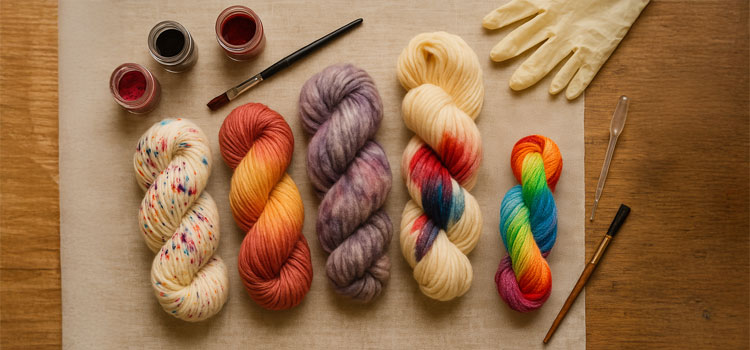
Creative Techniques for Artisan Fiber Dyeing
Beyond uniform dyeing, there’s a whole world of artistic fiber dyeing techniques that allow you to give your creations a unique personality. Here are some of the most popular methods — all doable at home with a bit of courage, curiosity, and the right products.
1. Speckle Dyeing (Freckled Effect)
A favorite among indie dyers, this method involves sprinkling dry dye powder directly onto damp, pre-soaked fiber laid flat in a tray or dish.
-
🟢 Result: Vibrant, uneven, dynamic spots of color
-
✅ Works especially well with acid dyes like Jacquard or Greener Shades in an acidic environment (e.g., vinegar)
-
💡 Best on superwash wool for optimal spread without felting
Pro Tip: Work in small sections and set the color using steam or a steamer oven to preserve those gorgeous splatters.
2. Snow Dyeing
As poetic as it is spectacular: cover the (ideally damp) fiber with fresh snow, sprinkle powdered dye over the top, and let the melting snow carry the pigment through the fiber.
-
🧵 Ideal for plant fibers like cotton, linen, or bamboo (using Procion MX)
-
🐑 Can also work on animal fibers with Jacquard Acid Dyes — as long as you heat afterward to set
What You Need:
-
A wire rack over a basin, clean snow or crushed ice, gloves, and a bit of timing (perfect in a Quebec winter, or simulate with crushed ice).
3. Microwave Dyeing
A quick and easy technique for small batches.
-
Wrap the dyed fiber in plastic (in acidic solution)
-
Microwave at medium power for 30-second intervals until it reaches approx. 80–90°C (176–194°F)
-
Let sit before rinsing
⚠️ Safety Warning: Never use a microwave shared with food. Always work in a well-ventilated area. Recommended with Jacquard or Ashford dyes.
4. Dip Dye / Ombré Effect
For a gradual color fade, dip your fiber progressively deeper into the dye bath or vary the soaking time.
-
The longer the fiber stays in the dye, the more intense the color
-
Great for scarves, sock yarns, and handspinning fibers
-
Can be combined with a second dye bath for a blended two-tone effect
5. Tie-Dye (Resist Technique)
Although best known with cotton, tie-dye also works with wool or silk if you adapt the method:
-
Tie or bind sections of your fiber with string or elastics
-
Apply different dyes to each section
-
Let it sit, then fix with steam or microwave
With plant fibers, tie-dye + Procion MX = bold, crisp results.
Pro Tip: Steam each color section separately to get cleaner lines or “cracked” transitions (crackle effects).
6. Hand-Painting with Brushes or Syringes
Perfect for detail-oriented or abstract-minded dyers:
Apply diluted dye onto fiber laid flat using:
-
Paintbrushes
-
Syringes
-
Droppers
Then fix the dye:
-
With a homemade steamer oven
-
Or a hot water bath, depending on the fiber3
✅ Which Technique for Which Fiber?
| Technique | Best Fiber Types | Recommended Dyes |
|---|---|---|
| Speckle | Wool, Silk | Jacquard, Ashford, Greener Shades |
| Snow Dyeing | Cotton, Linen, Bamboo | Procion MX |
| Microwave | Wool, Silk | Jacquard, Ashford |
| Ombré | All fiber types | Any dye matched to fiber |
| Tie-Dye | Cotton, Linen, Soft Wool | Procion MX, Jacquard |
| Hand-Painting | Carded wool, fabric | Diluted Jacquard or Procion |
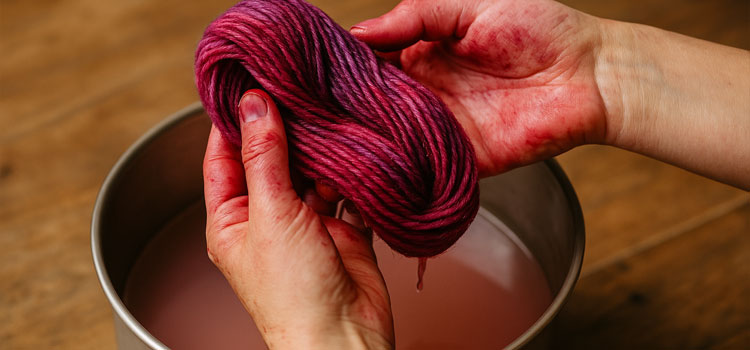
Common Mistakes in Fiber Dyeing — and How to Avoid Them
Even with the best dyes and intentions, a single oversight or rough movement can ruin a dye session. Here are the most common mistakes dyers make… and how to avoid them easily.
1. Felting Wool During the Dyeing Process
Mistake: Stirring wool too vigorously in hot water or causing a sudden temperature shift.
Solutions:
-
Avoid any harsh movements or fast stirring.
-
Keep the temperature stable and increasing gradually (never add cold water to hot, or vice versa).
-
Never rub or wring the wool. Instead, gently lift it, drain it, and let it cool before rinsing.
🧼 Bonus tip: Rinse with lukewarm water first, then gradually cooler — never the opposite.
2. Uneven or Blotchy Color
Mistake: Fibers weren’t properly pre-washed or soaked, or dye bath wasn’t stirred correctly.
Solutions:
-
Always pre-wash your fiber with Synthrapol or mild soap to remove oils and residues.
-
Soak for 15–30 minutes for proper saturation.
-
Stir slowly and regularly in the bath — especially during the first 10 minutes.
💡 Creative note: For speckle or ombré effects, color variation is part of the charm — embrace it!
3. Poor Color Fixation
Mistake: Not enough fixative (vinegar, citric acid, soda ash) or incorrect bath temperature.
Solutions:
-
Follow dye instructions carefully:
-
Jacquard / Ashford / Greener Shades: 80–95°C (176–203°F), pH ~4.5
-
Procion MX: Add soda ash after 10–15 minutes in the bath
-
-
Don’t exceed the recommended temperature — too hot can damage fibers
📏 Fixative tip:
1% dye = medium color / 2% dye = deep color
Always calculate based on total fiber weight.
4. Color Bleeds After Rinsing
Mistake: Not rinsing long enough or skipping the final soap wash.
Solutions:
-
Rinse first with lukewarm water, then cooler
-
Soak 5–10 minutes with a neutral textile soap (like Synthrapol®)
-
Repeat rinsing until water is totally clear
🧽 For bold colors (like turquoise, red, or black), expect multiple rinses — that’s normal!
5. Incompatible Fiber and Dye
Mistake: Using acid dye on cotton or Procion on untreated wool.
Solutions:
-
Always double-check fiber/dye compatibility
-
Use product instructions or consult your supplier
-
For blended fibers (like wool + bamboo), test a small batch before committing
📌 Quick reference chart:
| Fiber Type | Ideal Dye Type |
|---|---|
| Wool, Silk, Alpaca | Jacquard, Ashford, Greener Shades |
| Cotton, Linen | Procion MX |

Frequently Asked Questions About Fiber Dyeing
Can I dye alpaca or angora fiber?
Absolutely! These animal fibers require acid dyes such as Jacquard, Ashford, or Greener Shades. Since alpaca and angora are more delicate:
-
Soak thoroughly before dyeing
-
Heat the bath very gradually
-
Avoid any rough agitation to prevent felting
🔍 Aim for gentle simmering and maintain pH around 4.5 for best results.
Can I use natural (plant-based) dyes on my fibers?
Yes — but it requires more prep. Botanical dyes (like onion skins, turmeric, madder root, etc.) are great for animal fibers, but you’ll often need a mordant (like alum or cream of tartar) to help color bind properly.
They’re a wonderful eco-friendly option, but:
-
The colors tend to be softer or earthier
-
Colorfastness depends on the plant used
-
Dyeing time is usually longer
🛍️ For a ready-to-use, eco-friendly alternative, try Greener Shades, which offer vibrant color with no heavy metals.
Can I dye a finished knitted or woven piece?
Yes — with care. First, check:
-
The exact fiber content (100% wool, cotton, etc.)
-
That it’s untreated (no stain repellents, no heavy superwash finish)
Use a dye bath (not surface dyeing), and avoid agitation. Expect a more tonal, artisanal result than with undyed yarn.
👚 Note: Synthetic seams or blended yarns won’t take the dye.
How do I make sure the color won’t bleed after washing?
It’s all about proper fixation and a good rinse. Make sure to:
-
Use vinegar or citric acid for acid dyes
-
Use soda ash for Procion MX dyes
-
Finish with a soapy rinse using Synthrapol®
and repeat rinses until the water runs clear
💡 Pro tip: Add a fixative like Rit ColorStay for even better washfastness.
Why do some dye recipes call for salt or vinegar?
These additives help the dye bond to the fiber:
-
Vinegar or citric acid lowers the pH for acid dyes (ideal for wool, silk, alpaca)
-
Salt improves dye uptake for Procion MX dyes on plant-based fibers
📊 For medium color: use 1–2% dye based on the fiber weight (WOF), and adjust your other ingredients accordingly.
How should I clean my dye tools afterward?
-
Wash with hot, soapy water
-
Never reuse dye pots or utensils for food
-
Always wear gloves when cleaning
-
To remove spills from surfaces: use vinegar, rubbing alcohol, or a gentle cleaner (avoid bleach on stainless steel)
🧴 Storage tip: Keep dye powders in a dry, sealed container away from kids and pets.
Where to Buy Fiber and Dyes in Canada
Looking for reliable, high-quality supplies to start (or expand) your fiber dyeing journey?
At Artigina.com, we’re proud to be a Quebec-based business specializing in:
Dyeable Fibers
-
Superwash merino wool – perfect for even absorption and bold colors
-
Alpaca, silk, wool/bamboo blends and more
-
Plant fibers like linen, cotton, and bamboo — ideal for Procion MX dyes
➡️ Available in skeins or loose fiber, ready to dye.
Dyes Available at Artigina
| Brand | Type | Best For | Key Benefits |
|---|---|---|---|
| Jacquard Acid Dyes | Acid | Wool, silk, alpaca | Bright colors, huge range, excellent hold |
| Ashford Dyes | Acid | Wool, silk | Easy-to-use, beginner-friendly |
| Greener Shades | Eco-friendly acid | Animal fibers | No heavy metals, GOTS compliant |
| Procion MX | Fiber-reactive | Cotton, linen, bamboo | Cold dyeing, great for tie-dye and batik |
Also in Stock
-
Specialized tools: scales, spoons, thermometers
-
Fixatives: soda ash, citric acid, Synthrapol
-
All-in-one kits to get started with confidence
Why Choose Artigina?
-
✅ Quebec-based, family-run business
-
✅ Products selected and tested by passionate fiber artists
-
✅ Fast, friendly customer support
-
✅ Shipping across Canada — fast and carefully packed
-
✅ Free educational content: blog posts, tutorials, downloadable guides
🎯 Whether you need dyeable yarn or the perfect dye, Artigina is here to support your journey from start to finish.

Conclusion: Let Your Creativity Flow
Fiber dyeing is more than just a technique — it’s a way to express yourself, personalize your handmade pieces, and reconnect with the joy of crafting.
Whether you’re aiming for bold tones on merino or soft hues from natural dyes, each fiber you dye becomes part of a unique creative process.
With the right tools, quality dyes — like Jacquard, Ashford, Greener Shades, or Procion MX — and a bit of know-how, you can transform bare fiber into beautiful skeins ready to spin, weave, or knit.
At Artigina, we’re committed to helping you succeed — whether it’s your very first try or your latest masterpiece.
💻 Visit our online store, browse our guides, or get in touch for personalized advice.
🎨 It’s time to dip your fiber… and let your imagination run wild.
 English
English Français
Français
